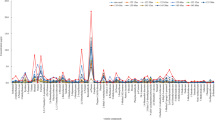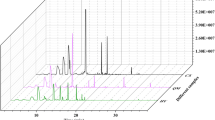Abstract
To qualitatively and quantitatively distinguish the boundaries of commercial strong-, mellow- and light- fragrant rapeseed oils in Chinese market, 24 commercial rapeseed oils were symmetrically analyzed to characterize their profiles of physical/chemical components, key aroma compounds, and nutrients and their concentrations. Results showed that strong- fragrant flavor rapeseed oil had highest AV of 0.25–1.73 mg/g, PV of 0.50–3.37 mmol/kg, Lovibond red reading of > 2.0, total tocopherol of > 505 mg/kg, total sterols of over 4445 mg/kg, and average CoQ10 contents of > 204 mg/kg, followed by mellow- and light- fragrant flavor rapeseed oils. Strong- fragrant rapeseed oil held the highest roasted odor and nutty flavor, while mellow- fragrant rapeseed oil had more acceptable taste with highest soft and spicy taste values. The typical volatile compounds such as hexanal, dimethyl sulfoxide and 5-hexenenitrile could be used to quantitatively and qualitatively distinguish three types of rapeseed oils using PCA Cluster analysis. These findings would provide a reference to multi-dimensionally distinguish and select the favorable rapeseed oil for consumers from these types of commercial fragrant rapeseed oils.


Similar content being viewed by others
Data availability
The datasets generated and/or analyzed during the current study are available from the corresponding author on reasonable request.
References
Y.M. Cui, P.F. Hao, B.J. Liu, X.H. Meng, Effect of traditional chinese cooking methods on fatty acid profiles of vegetable oils. Food Chem. 233, 77–84 (2017). https://doi.org/10.1016/j.foodchem.2017.04.084
N.T. Dunford, Enzyme aided oil and oilseed processing: opportunities and challenges. Curr. Opin. Food Sci. 100943. (2022). https://doi.org/10.1016/j.cofs.2022.100943
B.G. Laviola, E.V. Rodrigues, A. dos Santos, L.P.R. Teodoro, L.A. Peixoto, P.E. Teodoro, L.L. Bhering, Breeding strategies to consolidate canola among the main crops for biofuels. Euphytica. 218(1), 1–25 (2022). https://doi.org/10.1007/s10681-021-02955-0
S.C. Chew, Cold-pressed rapeseed (Brassica napus) oil: Chemistry and functionality. Food Res. Int. 131, 108997 (2020). https://doi.org/10.1016/j.foodres.2020.108997
Y.J. Xu, F. Jiang, J. Song, X. Yang, N. Shu, L. Yuan, C.P. Tan, Y. Liu, Understanding of the role of pretreatment methods on Rapeseed Oil from the perspective of Phenolic Compounds. J. Agr Food Chem. 68(33), 8847–8854 (2020). https://doi.org/10.1021/acs.jafc.0c03539
K. Ganesan, K. Sukalingam, B. Xu, Impact of consumption and cooking manners of vegetable oils on cardiovascular diseases – A critical review. Trends Food Sci. Technol. 71, 132–154 (2018). https://doi.org/10.1016/j.tifs.2017.11.003
S. Azadmard-Damirchi, F. Habibi-Nodeh, J. Hesari, M. Nemati, B.F. Achachlouei, Effect of pretreatment with microwaves on oxidative stability and nutraceuticals content of oil from rapeseed. Food Chem. 121(4), 1211–1215 (2010). https://doi.org/10.1016/j.foodchem.2010.02.006
Y.F. Zhang, X.Y. Zhai, L. Gao, J. Jin, Q.H. Zhong, C.C. Sun, L.P. Yan, R.J. Liu, C.C. Akoh, Q.Z. Jin, X.G. Wang, Quality of wood-pressed rapeseed oil. J. Am. Oil Chem. Soc. 94(6), 767–777 (2017). https://doi.org/10.1007/s11746-017-2986-y
Q. Zhou, X. Jia, Q.C. Deng, H. Chen, H. Tang, F.H. Huang, Quality evaluation of rapeseed oil in chinese traditional stir-frying. Food Sci. Nutr. 7(11), 3731–3741 (2019). https://doi.org/10.1002/fsn3.1232
K. Kraljić, T. Stjepanović, M. Obranović, M. Pospišil, S. Balbino, D. Škevin, Influence of conditioning temperature on the quality, nutritional properties and volatile profile of virgin rapeseed oil. Food Technol. Biotechnol. 56(4), 562 (2018). https://doi.org/10.17113/ftb.56.04.18.5738
Y.F. Zhang, Y.Q. Wu, S.R. Chen, B.B. Yang, H. Zhang, X.G. Wang, M. Granvogl, Q.Z. Jin, Flavor of rapeseed oil: an overview of odorants, analytical techniques, and impact of treatment. Compr. Rev. Food Sci. Food Saf. 20(4), 3983–4018 (2021). https://doi.org/10.1111/1541-4337.12780
H.H. Jeleń, M. Obuchowska, R. Zawirska-Wojtasiak, E. Wasowicz, Headspace solid-phase microextraction use for the characterization of volatile compounds in vegetable oils of different sensory quality. J. Agr Food Chem. 48(6), 2360–2367 (2000). https://doi.org/10.1021/jf991095v
G. Pollner, P. Schieberle, Characterization of the key odorants in commercial cold-pressed oils from unpeeled and peeled rapeseeds by the sensomics approach. J. Agr Food Chem. 64(3), 627–636 (2016). https://doi.org/10.1021/acs.jafc.5b05321
American Oil Chemists’ Society, Official Methods and Recommended Practices of the AOCS (AOCS Press, Champaign, 1997)
American Oil Chemists’ Society, Official Methods and Recommended Practices of the AOCS (AOCS Press, Champaign, 1998)
A.S. Al-Khalifa, Physicochemical characteristics, fatty acid composition, and lipoxygenase activity of crude pumpkin and melon seed oils. J. Agr Food Chem. 44(4), 964–966 (1996). https://doi.org/10.1021/jf950519s
L.R. Xu, X.Z. Yu, M.J. Li, J. Chen, X.G. Wang, Monitoring oxidative stability and changes in key volatile compounds in edible oils during ambient storage through HS-SPME/GC–MS. Int. J. Food Prop. 20(sup3), S2926–S2938 (2017). https://doi.org/10.1080/10942912.2017.1382510
B.Y. Jing, R. Guo, M.Z. Wang, L.Y. Zhang, X.Z. Yu, Influence of seed roasting on the quality of glucosinolate content and flavor in virgin rapeseed oil. LWT-Food Sci. Technol. 126, 109301 (2020). https://doi.org/10.1016/j.lwt.2020.109301
T. Potočnik, M.R. Cizej, I.J. Košir, Influence of seed roasting on pumpkin seed oil tocopherols, phenolics and antiradical activity. J. Food Compos. Anal. 69, 7–12 (2018). https://doi.org/10.1016/j.jfca.2018.01.020
S. Lunetta, M. Roman, A. Chandrah, T. Edamura, T. Honda, M. LeVanseler K Nagarajan, N. Patel, K. Reif, B. Schaneberg, D. Sullivan, L. Trussardo, Collaborators, Determination of coenzyme Q10 content in raw materials and dietary supplements by high-performance liquid chromatography-UV: collaborative study. J. AOAC Int. 91(4), 702–708 (2008). https://doi.org/10.1093/jaoac/91.4.702
Gordon, 7 - Factors affecting lipid oxidation, Editor(s): R. Steele, In Woodhead Publishing Series in Food Science, Technology and Nutrition, Understanding and Measuring the Shelf-Life of Food, Woodhead Publishing, Pages 128–141, ISBN 9781855737327, (2004). https://doi.org/10.1533/9781855739024.1.128
L.Y. Zheng, C. Ji, J.L. Jin, D. Xie, R.J. Liu, X.G. Wang, Q.Z. Jin, J. Huang, Effect of moisture and heat treatment of corn germ on oil quality. J. Am. Oil Chem. Soc. 95(3), 383–390 (2018). https://doi.org/10.1002/aocs.12032
F.X. Sun, D.S. Zhao, Z.M. Zhou, Determination of oil color by image analysis. J. Am. Oil Chem. Soc. 78(7), 749–752 (2001). https://doi.org/10.1007/s11746-001-0337-5
M.E. Carrín, A.A. Carelli, Peanut oil: compositional data. Eur. J. Lipid Sci. Technol. 112(7), 697–707 (2010). https://doi.org/10.1002/ejlt.200900176
C. Alimentarius, Codex standard for named vegetable oils. Codex stan 210, 1–13 (1999)
M. Wroniak, A. Rękas, A. Siger, M. Janowicz, Microwave pretreatment effects on the changes in seeds microstructure, chemical composition and oxidative stability of rapeseed oil. LWT-Food Sci. Technol. 68, 634–641 (2016). https://doi.org/10.1016/j.lwt.2016.01.013
K. Kraljić, D. Škevin, M. Pospišil, M. Obranović, S. Neđeral, T. Bosolt, Quality of rapeseed oil produced by conditioning seeds at modest temperatures. J. Am. Oil Chem. Soc. 90(4), 589–599 (2013). https://doi.org/10.1007/s11746-012-2195-7
A. Mariod, B. Matthäus, I.H. Hussein, Fatty acids, tocopherols and sterols of Cephalocroton cordofanus in comparison with sesame, cotton, and groundnut oils. J. Am. Oil Chem. Soc. 88(9), 1297–1303 (2011). https://doi.org/10.1007/s11746-011-1796-x
Y. Wu, R.S. Zhou, Z. Wang, B. Wang, Y. Yang, X.R. Ju, R. He, The effect of refining process on the physicochemical properties and micronutrients of rapeseed oils. PloS One. 14(3), e0212879 (2019). https://doi.org/10.1371/journal.pone.0212879
Y. Wu, W.Q. Yuan, X. Han, J.Z. Hu, L.Q. Yin, Z.L. Lv, Integrated analysis of fatty acid, sterol and tocopherol components of seed oils obtained from four varieties of industrial and environmental protection crops. Ind. Crop Prod. 154, 112655 (2020). https://doi.org/10.1016/j.indcrop.2020.112655
R.A. Ferrari, E. Schulte, W. Esteves, L. Brühl, K.D. Mukherjee, Minor constituents of vegetable oils during industrial processing. J. Am. Oil Chem. Soc. 73(5), 587–592 (1996). https://doi.org/10.1007/BF02518112
J.M. Villalba, C. Parrado, M. Santos-Gonzalez, F.J. Alcain, Therapeutic use of coenzyme Q10 and coenzyme Q10-related compounds and formulations. Expert Opin. Investig Drugs 19(4), 535–554 (2010). https://doi.org/10.1517/13543781003727495
I. Pravst, K. Žmitek, J. Žmitek, Coenzyme Q10 contents in foods and fortification strategies. Crit. Rev. Food Sci. Nutr. 50(4), 269–280 (2010). https://doi.org/10.1080/10408390902773037
P. Pregnolato, M. Maranesi, T. Mordenti, E. Turchetto, V. Barzanti, G. Grossi, Coenzymes Q10 and Q9 content in some edible oils. Riv Ital. Sostanze Grasse 10, 503–505 (1994)
Q. Zhou, X. Jia, Y.Z. Yao, B. Wang, C.Q. Wei, M. Zhang, F.H. Huang, Characterization of the aroma-active compounds in commercial fragrant rapeseed oils via monolithic material sorptive extraction. J. Agr Food Chem. 67(41), 11454–11463 (2019). https://doi.org/10.1021/acs.jafc.9b05691
A. Szydłowska-Czerniak, A. Tułodziecka, M. Momot, B. Stawicka, Physicochemical, antioxidative, and sensory properties of refined rapeseed oils. J. Am. Oil Chem. Soc. 96(4), 405–419 (2019). https://doi.org/10.1002/aocs.12199
A. Gracka, H.H. Jeleń, M. Majcher, A. Siger, A. Kaczmarek, Flavoromics approach in monitoring changes in volatile compounds of virgin rapeseed oil caused by seed roasting. J. Chromatogr. A 1428, 292–304 (2016). https://doi.org/10.1016/j.chroma.2015.10.088
C. Tangduangdee, S. Bhumiratana, S. Tia, The role of moisture movement and crust thermal property on heat and mass process during deep-fat frying. Int. Commun. Heat. Mass. Transf. 31(1), 73–84 (2004). https://doi.org/10.1016/S0735-1933(03)00203-3
R.M. Costa, F.A.R. Oliveira, Modelling the kinetics of water loss during potato frying with a compartmental dynamic model. J. Food Eng. 41(3–4). (1999). https://doi.org/10.1016/S0260-8774(99)00095-3
Q. Zhou, H. Tang, X. Jia, C. Zheng, F. Huang, M. Zhang, Distribution of glucosinolate and pungent odors in rapeseed oils from raw and microwaved seeds. Int. J. Food Prop. 21(1), 2296–2308 (2018). https://doi.org/10.1080/10942912.2018.1514632
K. Kraljić, D. Škevin, L. Barišić, M. Kovačević, M. Obranović, I. Jurčević, Changes in 4-vinylsyringol and other phenolics during rapeseed oil refining. Food Chem. 187, 236–242 (2015). https://doi.org/10.1016/j.foodchem.2015.04.039
T. Chen, X.P. Chen, B. Chen, Gas chromatography-ion mobility spectrometry detection of odor fingerprint as markers of rapeseed oil refined grade. J. Anal. Methods Chem. 2019. (2019). https://doi.org/10.1155/2019/3163204
Q. Zhang, Y.C. Ding, S.Q. Gu, S.C. Zhu, X.X. Zhou, Y.T. Ding, Identification of changes in volatile compounds in dry-cured fish during storage using HS-GC-IMS. Food Res. Int. 137, 109339 (2020). https://doi.org/10.1016/j.foodres.2020.109339
Funding
This work was supported by funding from Jiangsu Special Research and Development Grant for Northern Jiangsu Area, China (SZ-YC202145).
Author information
Authors and Affiliations
Contributions
F.-J.C. conceived of the study and participated in its design and coordination and drafted the manuscript. M.T., H.-B.-Z, P.-P. Y, C. C., T.-L. Z. performed experiments, analyzed results and helped to draft the manuscript. Z.-W. C., J.-C. S., X.-Y. Z. and X.-Q.S performed partial experiments and analyzed results. All authors read and approved the manuscript.
Corresponding authors
Ethics declarations
Conflict of interest
All authors declare that they have no conflict of interest.
Ethical approval
This article does not contain any studies with human participants or animals performed by any of the authors.
Additional information
Publisher’s note
Springer Nature remains neutral with regard to jurisdictional claims in published maps and institutional affiliations.
Rights and permissions
Springer Nature or its licensor (e.g. a society or other partner) holds exclusive rights to this article under a publishing agreement with the author(s) or other rightsholder(s); author self-archiving of the accepted manuscript version of this article is solely governed by the terms of such publishing agreement and applicable law.
About this article
Cite this article
Tan, M., Zhang, HB., Ye, PP. et al. Distinguishing strong, mellow and light fragrant rapeseed oils in China using physicochemical, nutritional and aroma profiles. Food Measure 17, 1671–1684 (2023). https://doi.org/10.1007/s11694-022-01729-z
Received:
Accepted:
Published:
Issue Date:
DOI: https://doi.org/10.1007/s11694-022-01729-z




